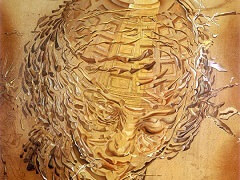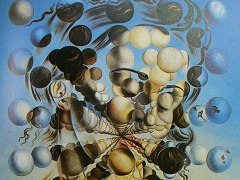The Pharmacist of Ampurdan Seeking Absolutely Nothing, 1936 by Salvador Dali

Though Dali's image of him is specter-like, the busy-about-nothing pharmacist was a real person, accurately depicted. Here he could well be a statue, like one of the mysterious monuments in the paintings of Paul Delvaux and Georges de Chirico, contemporaries who certainly influenced Dali.
The landscape is the Ampurdan plain as it appears in so many of Dali's paintings, with its long perspectives and surrounding hills. As so often in his work, the title serves to undermine the content of the picture itself, making it irrational. Dali pursued a similar strategy with regard to framing, insisting on putting pictures that were often quite small into ornate, heavy, old-fashioned frames that might initially deceive the spectator into believing that the subject would be treated in an equally traditional style.























